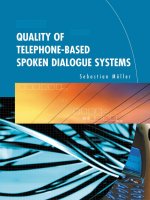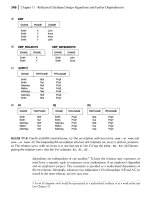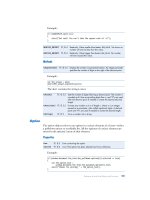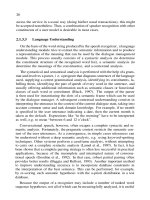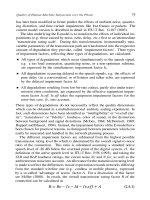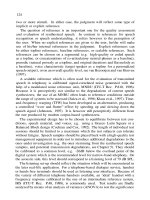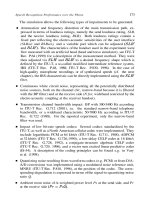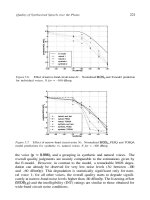Quality of Telephone-Based Spoken Dialogue Systems phần 10 potx
Bạn đang xem bản rút gọn của tài liệu. Xem và tải ngay bản đầy đủ của tài liệu tại đây (544.18 KB, 52 trang )
418
Teil
C
1.
Gesamteindruck:
2. Die Ausdrucksweise
des Systems war
3. Das System
reagierte
4. Sie hätten eine bessere
Hilfestellung vom
System erwartet:
5. Das System konnte
alle meine Fragen
beantworten:
6. Missverständnisse
konnten leicht
ausgeräumt werden:
7. Das System hat den
Gesprächsverlauf
bestimmt:
8. Sie konnten ohne
Probleme mit dem
System umgehen:
9. Sie sind von den
Gesprächen mit
diesem System
10. Die Gespräche haben
Spaß gemacht:
11. Sie fühlen sich über
die Fähigkeiten des
Systems ausreichend
informiert:
12. Der Anruf beim
System hat sich
Gelohnt:
extrem
schlecht
schlecht
dürftig
ordenttich
gut
ausgezeichnet
ideal
klar
unklar
höflich
unhöflich
trifft zu
tritft
nicht
zu
trifft
zu
trifft
nicht
zu
trifft
zu
trifft
nicht
zu
trifft
zu
trifft
nicht
zu
trifft
zu
trifft
nicht
zu
beeindruckt
enttäuscht
trifft
zu
trifft
nicht
zu
trifft
zu
trifft
nicht
zu
trifft
zu
trifft
nicht
zu
Questionnaires
419
13. Sie empfanden die
Auskunftsmöglichkeit
als
14. Sie schätzen
das
System ein als
15. Sie verwenden lieber
eine andere
Auskunftsquelle:
16. Die Bedienung
des Systems war
17. Sie bevorzugen eine
mit einem Menschen
besetzte Auskunfts-
stelle:
18. Sie würden dieses
System noch einmal
Benutzen:
19.
Was hat Ihnen am System gefallen?
20. Was hat Sie am System gestört?
21. Haben Sie Verbesserungsvorschläge für das System?
hilfreich
nicht hilfreich
vertrauenswürdig
zweifelhaft
trifft
zu
trifft
nicht
zu
einfach
kompliziert
trifft
zu
trifft nicht zu
trifft
zu
trifft
nicht
zu
420
Nachdem Sie nun Erfahrungen mit BoRIS gemacht haben, bitten wir Sie, die
folgenden Fragen noch einmal zu beantworten.
Wenn Sie bei einem Restaurant-Auskunftssystem anrufen, wie wichtig ist es Ihnen
22.1 ein normales Gespräch zu führen wie mit einem Menschen?
22.2 von einer freundlichen Stimme bedient zu werden?
22.3 dem System Fragen stellen zu können?
22.4 vom System Fragen
(Scar
übre Vorlieben gestellt zu bekommen?
22.5 schnell die gewünschte Information zu bekommen?
22.6 das System leicht bedienen zu können?
22.7 vom System erklärt zu bekommen, wie es Ihnen helfen kann?
Viele
n
Dank für Ihre Mühe!
wichtig nicht wichtig
wichtig nicht wichtig
wichtig
nicht wichtig
wichtig
nicht wichtig
wichtig nicht wichtig
wichtig
nicht wichtig
wichtig nicht wichtig
Questionnaires
421
English Translation
Part
A
Personal data
Gender:
Age:
Profession / education:
Region
/
city
of
birth:
Current residence:
1.0
2.0
3.0
4.0
5.0
How often do you eat out on an average?
How would you search for a restaurant when you are in a foreign place (multiple choices
possible)?
What is important for you when you decide on a restaurant (multiple choices possible)?
1.1.
1.2
1.3
1.4
1.5
3.1
3.2
3.3
3.4
3.5
Have you ever used an automatic speech-based information system?
yes
3.6
3.7
3.8
3.9
3.10 Other:
no
4.1. If yes, on which occasion?
4.1.1 How would you characterize your experience with it?
Do you have experience with a speech understanding system?
yes
no
female
male
years
times a week times a month
times a year
1.6
1.7
1.8 Other:
Magazines
Commercial flyers
City guide
Telephone book
Internet
Tips from friends
Calling a automatic
speech-based system
Price
Food type
Food quality
Variety of food offered
Location
Ambience
Opening hours
Service speed
Service friendliness
extremely
bad
bad
poor
fair
good
excellent
ideal
422
5.1
.
If yes, what kind of system?
6.0
7.0
8.0
Do you have experience with synthesized speech?
6.1. If yes, on which occasion?
What information about a restaurant do you want to get from an information
system?
If you would call a restaurant information system, how important is it
8.1 to have a normal conversation just like with a human?
8.2 to be served by a friendly voice?
8.3 that you can ask questions to the system?
8.4 that the system asks questions to you about your preferences?
8.5 to get the desired information quickly?
8.6 that the system can be used easily?
8.7 to get help from the system?
yes
no
important
unimportant
important unimportant
important
unimportant
important
unimportant
important
unimportant
important
unimportant
important
unimportant
Questionnaires
423
Par
t
B
Overall impression:
Informatio
n
obtained from the system
1. The system provided
the desired information:
2. The provided
information was
3. The information
was
4. you would rate the
information as
Communication with the system
5. How well did you
feel understood by
the system?
6. you had to concentrate
in order to understand
what the system expected
from you:
7. How well was the
system acoustically
intelligible?
System behavior
8. You knew at each point of
the dialogue what the
system expected from you:
9. In your opinion, the
system processed your
specifications correctly:
10. The system’s behavior
was always as you
expected:
extremely
bad
bad
poor
Mr
good
excellent
ideal
yes no
complete
incomplete
clear
unclear
wrong
true
extremely
bad
bad
poor
fair
good
excellent
ideal
yes
no
extremely
bad
bad
poor
fair
good
excellent
ideal
yes
no
yes
no
yes
no
424
11. How often did the system
make mistakes?
12. The system reacted in
the same way as humans
do:
13. The system
reacted
14. You were able to
control the dialogue
in the desired way:
15. The system
reacted
16. The system
reacted in a way:
Dialogue
17. The system utterances
were
18. You perceived the
dialogue as
19. The course of the
dialogue was
20. The dialogue
was
21. The course of the
dialogue was
Your impression of the system
22. The system’s voice
was
23 . Overall, you ar e
satisfied with the
dialogue:
frequently
rarely
yes
no
flexibly
inflexibly
yes
no
too fast
adequatly
too slowly
friendly
unfriendly
short
long
natural
unnatural
clear
confusing
too short
adequate
too long
smooth
bumpy
natural
unnatural
yes
no
Questionnaires
425
Personal impression
24. You perceived the
dialogu
e
as
25. During the dialogue,
you felt
pleasant
unpleasant
relaxed
stressed
426
Part
C
1. Overall impression:
2. The system’s way of
expression was
3. The system
reacted
4. You would have expected
more help from the
system:
5. The system was able
to answer all of your
questions:
6. Misunderstandings
could be cleared
easily:
7. The system controlled
the flow of the dialogue:
8. You were able to handle
the system without any
problems:
9. Regarding the
dialogues,
you
are
10. You enjoyed the
dialogues:
11. You
feel
adequately
informed about the
system’s possibilities:
12
.
The telephone calls
with the system were
worthwhile:
extremely
bad
bad
poor
fair
good
excellent
ideal
clear
unclear
politely
impolitely
yes
no
yes
no
yes
yes
no
no
yes
no
impressed
disappointed
yes
no
yes
no
yes
no
Questionnaires
427
13. You
perceived
this
possibility for obtaining
information as
14. You rate the system
as
15.
You
prefer
to use
another source of
information:
16. The handling of the
system was
17. You
prefer
a
human operator:
18. In the
future,
you
would
use the system again?
19. Which characteristics of the system did you like best?
20. Which characteristics of the system disturbed you mostly?
21. Do you have any proposals for system improvements?
helpful
not helpful
reliable
unreliable
yes
no
easy
complicated
yes
no
yes
no
428
With your current experiences of using BoRIS, we ask you to answer the following
questions once again.
22. If you would call a restaurant information system, how important is it
22.1 to have a normal conversation Just like with a human?
22.2 to be served by a friendly voice?
22.3 that you can ask questions to the system?
22.4 that the system asks questions to you about your preferences?
22.5 to get the desired information quickly?
22.6 that the system can be used easily?
22.7 to get help from the system?
Thank you for your effort!
important
unimportant
important
unimportant
important
unimportant
important
unimportant
important
unimportant
important
unimportant
important unimportant
References
Abe, K., Kurokawa, K., Taketa, K., Ohno, S., and Fujisaki, H. (2000). A New Method for
Dialogue Management in an Intelligent System for Information Retrieval. In: Proc. 6th Int.
Conf. on Spoken Language Processing (ICSLP 2000), 2:118–121, CHN–Beijing.
Allen, J., Ferguson, G., and Stent, A. (2001). An Architecture for More Realistic Conversational
Systems. In: Proc. of Intelligent User Interfaces 2001 (IUI-01), 1–8, USA–Santa Fe NM.
Amalberti, R., Carbonell, N., and Falzon, P. (1993). User Representations of Computer Systems
in Human-Computer Speech Interaction. International Journal on Man-Machine Studies,
38:547–566.
Andernach, T., Deville, G., and Mortier, L. (1993). The Design of a Real World Wizard of
Oz Experiment for a Speech Driven Telephone Directory Information System. In: Proc. 3rd
Europ. Conf. on Speech Communication and Technology (EUROSPEECH’93), 2:1165–1168,
D–Berlin.
Antoine, J Y., Bousquet-Vernhettes, C., Goulian, J., Kurdi, M. Z., Rousset, S., Vigouroux, N.,
and Villaneau, J. (2002). Predictive and Objective Evaluation of Speech Understanding:
The “Challenge” Evaluation Campaign of the I3 Speech Workgroup of the French CNRS.
In: Proc. 3rd Int. Conf. on Language Resources and Evaluation (LREC 2002), 2:529–536,
ES–Las Palmas.
Antoine, J Y., Siroux, J., Caelen, J., Villaneau, J., Goulian, J., and Ahafhaf, M. (2000). Obtaining
Predictive Results with an Objective Evaluation of Spoken Dialogue Systems: Experiments
with the DCR Assessment Paradigm. In: Proc. 2nd Int. Conf. on Language Resources and
Evaluation (LREC 2000), 2:713–720, GR–Athens.
Antoniol, G., Fiutem, R., Lazzari, G., and de Mori, R. (1998). System Architectures and
Applications. Spoken Dialogues with Computers, R. de Mori, ed., 583–609, Academic Press,
UK–London.
Araki, M. and Doshita, S. (1997). Automatic Evaluation Environment for Spoken Dialogue
Systems. In: Dialogue Processing in Spoken Language Systems, ECAI’96 Workshop, H–
Budapest, E. Maier, M. Mast, and S. LuperFoy, eds., Lecture Notes in Artificial Intelligence
No. 1236, 183–194, Springer, D–Berlin.
Arden, P. (1997). Subjective Assessment Methods for Text-To-Speech Systems. In: Proc. Speech
and Language Technology (SALT) Club Workshop on Evaluation in Speech and Language
Technology, 9–16, UK–Sheffield.
Atwell, E., Howarth, P., Souter, C., Baldo, P., Bisiani, R., Pezzotta, D., Bonaventura, P., Menzel,
W., Herron, D., Morton, R., and Schmidt, J. (2000). User-Guided System Development in
Interactive Spoken Language Education. Natural Language Engineering, 6(3-4):229–241.
430
Aust, H. and Oerder, M. (1995). Dialogue Control in Automatic Inquiry Systems. In: Proc.
ESCA Workshop on Spoken Dialogue Systems, P. Dalsgaard, L.B. Larsen, L. Boves, and I.
Thomsen, eds., 121–124, DK–Vigsø.
Aust, H., Oerder, M., Seide, F., and Steinbiss, V. (1995). The Philips Automatic Train Timetable
Information System. Speech Communication, 17:249–262.
Baekgaard, A., Bernsen, O., Brøndsted, T., Dalsgaard, P., Dybkjær, H., Dybkjær, L., Kristiansen,
J., Larsen, L. B., Lindberg, B., Maegaard, M., Music, B., Offersgaard, L., and Povlsen, C.
(1995). The Danish Spoken Language Dialogue Project: A General Overview. In: Proc.
ESCA Workshop on Spoken Dialogue Systems, P. Dalsgaard, L.B. Larsen, L. Boves, and I.
Thomsen, eds., 89–92, DK–Vigsø.
Baekgaard, A. (1995). A Platform for Spoken Dialogue Systems. In: Proc. ESCA Workshop
on Spoken Dialogue Systems, P. Dalsgaard, L.B. Larsen, L. Boves, and I. Thomsen, eds.,
105–108, DK–Vigsø.
Baekgaard, A. (1996). Dialogue Management in a Generic Dialogue System. In: Dialogue
Management in Natural Language Systems. Proc. 11th Twente Workshop on Language Tech-
nology (TWLT 11), University of Twente, S. LuperFoy, A. Nijholt, and G. V. van Zanten, eds.,
123–132, NL–Enschede.
Baggia, P. and Rullent, C. (1993). Partial Parsing as a Robust Parsing Strategy. In: Proc. Int. Conf.
Acoustics Speech and Signal Processing (ICASSP’93), 2:123–126, IEEE, USA–Piscataway
NJ.
Baggia, P., Castagneri, G., and Danieli, M. (1998). Field Trials of the Italian ARISE Train
Timetable System. In: Proc. IEEE 4th Workshop Interactive Voice Technology for Telecom-
munications Applications (IVTTA’98), 97–102, I–Torino.
Baggia, P., Castagneri, G., and Danieli, M. (2000). Field Trials of the Italian ARISE Train
Timetable System. Speech Communication, 31:355–367.
Baggia, P., Gerbino, E., Giachin, E., and Rullent, C. (1994). Experiences of Spontaneous
Speech Interaction with a Dialogue System. In: Progress and Prospects of Speech Research
and Technology, H. Niemann, R. de Mori, and G. Hanrieder, eds., 241–248, Infix, D–Sankt
Augustin.
Balestri, M., Foti, E., Nebbia, L., Oreglia, M., Salza, P. L., and Sandri, S. (1992). Comparison of
Natural and Synthetic Speech Intelligibility for a Reverse Telephone Directory Service. In:
Proc. 2nd Int. Conf. on Spoken Language Processing (ICSLP’92), 1:559–562, CND–Banff.
Bappert, V. and Blauert, J. (1994). Auditory Quality Evaluation of Speech-Coding Systems.
acta acustica, 2:49–58.
Basson, S., Springer, S., Fong, C., Leung, H., Man, E., Olson, M., Pitrelli, J., Singh, R., and
Wong, S. (1996). User Participation and Compliance in Speech Automated Telecommuni-
cations Applications. In: Proc. 4th Int. Conf. on Spoken Language Processing (ICSLP’96),
H.T. Bunnell and W. Idsardi, eds., 3:1680–1683, IEEE, USA–Piscataway NJ.
Bates, M. and Ayuso, D. (1991). A Proposal for Incremental Dialogue Evaluation. In: Proc.
DARPA Speech and Natural Language Workshop, 319–322, USA–Pacific Grove CA.
Bates, M., Bobrwo, R., Fung, P., Ingria, R., Kubala, F., Makhoul, J., Nguyen, L., Schwartz,
R., and Stallard, D. (1993). The BBN/HARC Spoken Language Understanding System. In:
Proc. Int. Conf. Acoustics Speech and Signal Processing (ICASSP’93), 2:111–114, IEEE,
USA–Piscataway NJ.
Bates, M., Boisen, S., and Makhoul, J. (1990). Developing an Evaluation Methodology for
Spoken Language Systems. In: Proc. DARPA Speech and Natural Language Workshop,
102–108, USA–Hidden Valley PA.
References
431
Baum, L. F. (1900). The Wonderful Wizard of Oz. Kansas Centennial Ed. (1999), University
Press of Kansas, USA-Lawrence KS.
Beerends, J. G., Hekstra, A. P., Rix, A. W., and Hollier, M. P. (2002). Perceptual Evaluation of
Speech Quality (PESQ) –The New ITU Standard for End-to-End Speech Quality Assessment.
Part II – Psychoacoustic Model. J. Audio Eng. Soc., 50(10):765–778.
Bel, N., Caminero, J., Hernández, L., Marimón, M., Morlesín, J. F., Otero, J. M., Relaño, J.,
Rodríguez, M. C., Ruz, P. M., and Tapias, D. (2002). Design and Evaluation of a SLDS for
E-Mail Access Through the Telephone. In: Proc. 3rd Int. Conf. on Language Resources and
Evaluation (LREC 2002), 2:537–544, ES–Las Palmas.
Bellotti, V., MacLean, A., and Moran, T. (1991). Generating Good Design Questions. Tech-
nical Report EPC-1991-136, Rank Xerox Research Centre, Cambridge Laboratory, UK-
Cambridge.
Bengler, K. (2000). Automotive Speech-Recognition – Success Conditions Beyond Recognition
Rates. In: Proc.2nd Int. Conf. on Language Resources and Evaluation (LREC 2000), 3:1357–
1359, GR–Athen.
Bennacef, S., Devillers, L., Rosset, S., and Lamel, L. (1996). Dialog in the RAILTEL Telephone-
Based System. In: Proc. 4th Int. Conf. on Spoken Language Processing (ICSLP’96), H.T.
Bunnell and W. Idsardi, eds., 1:550–553, IEEE, USA–Piscataway NJ.
Benoît, C., Emerard, F., Schnabel, B., and Tseva, A. (1991). Quality Comparisons of Prosodic
and of Acoustic Components of Various Synthesizers. In: Proc. 2nd Europ. Conf. on Speech
Communication and Technology (EUROSPEECH’91), 2:875–878, I–Genova.
Beranek, L. L. (1971). Noise and Vibration Control. McGraw-Hill, USA-New York NY.
Berger, J. (1998). Instrumentelle Verfahren zur Sprachqualitätsschätzung – Modelle auditiver
Tests. Doctoral dissertation, Christian-Albrechts-Universität Kiel (Arbeiten über Digitale
Signalverarbeitung No. 13, U. Heute, ed.), Shaker Verlag, D-Aachen.
Beringer, N., Kartal, U., Louka, K., Schiel, F., and Türk, U. (2002a). PROMISE–A Procedure
for Multimodal Interactive System Evaluation. In: Proc. LREC Workshop on Multimodal
Resources and Multimodal Systems Evaluation, 4 pages, ES–Las Palmas.
Beringer, N., Louka, K., Penide-Lopez, V., and Türk, U. (2002b). End-to-End Evaluation of
Multimodal Dialogue Systems: Can we Transfer Established Methods? In: Proc. 3rd Int.
Conf. on Language Resources and Evaluation (LREC 2002), 2:558–563, ES–Las Palmas.
Bernsen, N. O. (1997). Towards a Tool for Predicting Speech Functionality. Speech Communi-
cation, 23:181–210.
Bernsen, N. O. (2003). On-Line User Modelling in a Mobile Spoken Dialogue System. In:
Proc. 8th Europ. Conf. on Speech Communication and Technology (EUROSPEECH 2003 –
Switzerland), 2:737–740, CH–Geneva.
Bernsen, N. O. (2004). Measuring Relative Target User Group Success in Spoken Conversation
for Edutainment. In: Proc. LREC Workshop on Multimodal Corpora: Models of Human
Behaviour for the Specification and Evaluation of Multimodal Input and Output Interfaces,
17–20, P–Lisbon.
Bernsen, N. O., Dybkjær, H., and Dybkjær, L. (1996). Principles for the Design of Cooperative
Spoken Human-Machine Dialogue. In: Proc. 4th Int. Conf. on Spoken Language Processing
(ICSLP’96), H.T. Bunnell and W. Idsardi, eds., 2:729–732, IEEE, USA–Piscataway NJ.
Bernsen, N. O., Dybkjær, H., and Dybkjær, L. (1998). Designing Interactive Speech Systems:
From First Ideas to User Testing. Springer, D-Berlin.
Bernsen, N. O. and Dybkjær, L. (1997). The DISC Concerted Action. In: Proc. Speech
and Language Technology (SALT) Club Workshop on Evaluation in Speech and Language
Technology, 35–42, UK–Sheffield.
432
Bernsen, N. O. and Dybkjær, L. (1999). A Theory of Speech in Multimodal Systems. In: Proc.
ESCA Workshop on Interactive Dialogue in Multi-Modal Systems, P. Dalsgaard, C.–H. Lee,
P. Heisterkamp, and R. Cole, eds., 105–108, D–Kloster Irsee.
Bernsen, N. O. and Dybkjær, L. (2000). A Methodology for Evaluating Spoken Language
Dialogue Systems and Their Components. In: Proc. 2nd Int. Conf. on Language Resources
and Evaluation (LREC 2000), 2:183–188, GR–Athens.
Bernsen, N. O., Dybkjær, L., and Kiilerich, S. (2004). Evaluating Conversation with Hans
Christian Andersen. In: Proc. 4th Int. Conf. on Language Resources and Evaluation (LREC
2004), 3:1011–1014, P–Lisbon.
Billi, R. and Lamel, L. F. (1997). RailTel: Railway Telephone Services. Speech Communication,
23:63–65.
Billi, R., Canavesio, F., and Rullent, C. (1998). Automation of Telecom Italia Directory Assis-
tance Service: Field Trial Results. In: Proc. IEEE 4th Workshop Interactive Voice Technology
for Telecommunications Applications (IVTTA’98), 11–16, I–Torino.
Billi, R., Castagneri, G., and Danieli, M. (1996). Field Trial Evaluations of Two Different
Information Inquiry Systems. In: Proc. 3rd IEEE Workshop on Interactive Voice Technology
for Telecommunications Applications (IVTTA’96), 129–134, USA–Basking Ridge NJ.
Bimbot, F. and Chollet, G. (1997). Assessment of Speaker Verification Systems. In: Handbook
on Standards and Resources for Spoken Language Systems, D. Gibbon, R. Moore, and R.
Winski, eds., 408–480, Mouton de Gruyter, D–Berlin.
Black, E. (1997). Evaluation of Broad-Coverage Natural-Language Parsers. In: Survey of the
State of the Art in Human Language Technology, R. Cole, J. Mariani, A. Uszkoreit, H. Zaenen,
and V. Zue, eds., 420–422, Cambridge University Press and Giardini Editori, I–Pisa.
Blauert, J. (1997). Spatial Hearing: The Psychophysics of Human Sound Localization. The
MIT Press, USA-Cambridge MA.
Blauert, J. and Jekosch, U. (1996). Sound-Quality Evaluation – A Multilayered Problem. In:
Proc. EAA Tutorium on Aurally-Adequate Sound-Quality Evaluation, 17 pages, B–Antwerp.
Blaylock, N., Allen, J., and Ferguson, G. (2002). Synchronization in an Asynchronous Agent-
Based Architecture for Dialogue Systems. In: Proc. Third SIGdial Workshop on Discourse
and Dialogue, 1–10, USA–Philadelphia PA.
Bodden, M. and Jekosch, U. (1996). Entwicklung und Durchführung von Tests mit Versuchsper-
sonen zur Verifizierung von Modellen zur Berechnung der Sprachübertragungsqualität.
Project report, Institut für Kommunikationsakustik, Ruhr-Universität, D-Bochum.
Böhm, A. (1993). Maschinelle Sprachausgabe deutschen und englischen Textes. Doctoral
dissertation, Institut für Kommunikationsakustik, Ruhr-Universität Bochum, Shaker Verlag,
D-Aachen.
Boite, R., Bourlard, H., Dutoit, T., Hancq, J., and Leich, H. (2000). Traîtement de la parole.
Presses Polytechniques Universitaires Romandes, CH-Lausanne.
Bonneau-Maynard, H., Devillers, L., and Rosset, S. (2000). Predictive Performance of Dialogue
Systems. In: Proc. 2nd Int. Conf. on Language Resources and Evaluation (LREC 2000),
1:177–181, GR–Athen.
Borg, I. and Staufenbiel, T. (1993). Theorien und Methoden der Skalierung: Eine Einführung.
Verlag Hans Huber, CH-Bern.
Boros, M., Eckert, W., Gallwitz, F., Görz, G., Hanrieder, G., and Niemann, H. (1996). Towards
Understanding Spontaneous Speech: Word Accuracy vs. Concept Accuracy. In: Proc. 4th
Int. Conf. on Spoken Language Processing (ICSLP’96), H.T. Bunnell and W. Idsardi, eds.,
2:1009–1012, IEEE, USA–Piscataway NJ.
References
433
Bortz, J. (1995). Forschungsmethoden und Evaluation. Springer, D-Berlin.
Bourlard, H. and Morgan, N. (1998). Hybrid HMM/ANN Systems for Speech Recognition:
Overview and New Research Directions. In: Adaptive Processing of Sequences and Data
Structures, Int. Summer School on Neural Networks, I–Vietri sul Mare, C. L. Giles and M.
Gori, eds., Lecture Notes in Artificial Intelligence No. 1387, 389–417, Springer, D–Berlin.
Bourlard, H. and Wellekens, C. J. (1992). Links Between Markov Models and Multi-Layer
Perceptron. IEEE Trans. Pattern Analysis, Machine Intelligence, 12:1167–1178.
Boves, L. and den Os, E. (1998). Speaker Verification in Telecom Applications. In: Proc. IEEE
4th Workshop Interactive Voice Technology for Telecommunications Applications (IVTTA’98),
203–208, I–Torino.
Boyce, S. J. and Gorin, A. L. (1996). User Interface Issues for Natural Spoken Dialogue Systems.
In: Proc. 1996 Int. Symp. on Spoken Dialogue (ISSD 96), H. Fujisaki, ed., 65–68, USA–
Philadelphia.
Bronkhorst, A. W., Bosman, A. J., and Smoorenburg, G. F. (1993). A Model for Context Effects
in Speech Recognition. J. Acoust. Soc. Am., 93(1):499–509.
Bruce, G., Granström, B., Gustafson, K., Horne, M., House, D., and Touati, P. (1995). Towards
an Enhanced Prosodic Model Adapted to Dialogue Applications. In: Proc. ESCA Workshop
on Spoken Dialogue Systems, P. Dalsgaard, L.B. Larsen, L. Boves, and I. Thomsen, eds.,
201–204, DK–Vigsø.
Brüggen, M. (2001). Klangverfärbungen durch Rückwürfe und ihre auditive und instrumentelle
Kompensation. Doctoral dissertation, Institut für Kommunikationsakustik, Ruhr-Universität
Bochum, dissertation.de, D-Berlin.
Bub, T. and Schwinn, J. (1996). VERBMOBIL: The Evolution of a Complex Large Speech-
to-Speech Translation System. In: Proc. 4th Int. Conf. on Spoken Language Processing
(ICSLP’96), H.T. Bunnell and W. Idsardi, eds., 4:2371–2374, IEEE, USA–Piscataway NJ.
Buntschuh, B., Kamm, C. A., di Fabbrizio, G., Abella, A., Mohri, M., Narayanan, S., Zeljkovic,
I., Sharp, R. D., Wright, J. H., Marcus, S., Shaffer, J., Duncan, R., and Wilpon, J. G. (1998).
VPQ: A Spoken Language Interface to Large Scale Directory Information. In: Proc. 5th Int.
Conf. on Spoken Language Processing (ICSLP’98), 7:2863–2866, AUS–Sydney.
Button, G. (1990). Going Up a Blind Alley: Conflating Conversation Analysis and Compu-
tational Modelling. In: Computers and Conversation, P. Luff and N. Gilbert, eds., 67–90,
Academic Press, UK–London.
Caminero, J., González-Rodríguez, J., Ortega-García, J., Tapias, D., Ruz, P. M., and Solá,
M. (2002). A Multilingual Speaker Verification System: Architecture and Performance
Evaluation. In: Proc. 3rd Int. Conf. on Language Resources and Evaluation (LREC 2002),
2:626–631, ES–Las Palmas.
Carletta, J. (1996). Assessing Agreement on Classification Tasks: The Kappa Statistics. Com-
putational Linguistics, 22(2):249–254.
Carletta, J., Isard, A., Isard, S., Kowtko, J. C., Doherty-Sneddon, G., and Anderson, A. H.
(1997). The Reliability of a Dialogue Structure Coding Scheme. Computational Linguistics,
23(1):13–31.
Carletta, J. C. (1992). Risk Taking and Recovery in Task-Oriented Dialogue. PhD thesis,
University of Edinburgh, UK-Edinburgh.
Carroll, J., Briscoe, T., and Sanfilippo, A. (1998). Parser Evaluation: A Survey and a New
Proposal. In: Proc. 1st Int. Conf. on Language Resources and Evaluation (LREC’98), 1:447–
454, ES–Granada.
434
Casali, S. P., Williges, B. H., and Dryden, R. D. (1990). Effects of Recognition Accuracy and
Vocabulary Size of a Speech Recognition System on Task Performance and User Acceptance.
Human Factors, 32(2):183–196.
Chang, H. M. (2000). Is ASR Ready for Wireless Primetime: Measuring the Core Technology
for Selected Applications. Speech Communication, 31:293–307.
Charfuelán, M., Gómez, L. H., López, C. E., and Hemsen, H. (2002). A XML-Based Tool for
Evaluation of SLDS. In: Proc. 3rd Int. Conf. on Language Resources and Evaluation (LREC
2002), 2:551–557, ES–Las Palmas.
Chollet, G., Cochard, J L., Constantinescu, A., Jaboulet, C., and Langlais, P. (1996). Swiss
French PolyPhone and PolyVar: Telephone Speech Databases to Model Inter- and Intra-
Speaker Variability. Technical Report RR-96-01, IDIAP, CH-Martigny.
Chu, M. and Peng, H. (2001). An Objective Measure for Estimating MOS of Synthesized Speech.
In: Proc. 7th Europ. Conf. on Speech Communication and Technology (EUROSPEECH 2001
– Scandinavia), 3:2087–2090, DK–Aalborg.
Churcher, G. E., Atwell, E. S., and Souter, C. (1997a). Dialogue Management Systems: A Survey
and Overview. Report 97.06, School of Computer Studies, University of Leeds, UK-Leeds.
Churcher, G. E., Atwell, E. S., and Souter, C. (1997b). A Generic Template to Evaluate Integrated
Components in Spoken Dialogue Systems. In: Proc. Speech and Language Technology
(SALT) Club Workshop on Evaluation in Speech and Language Technology, 51–58, UK–
Sheffield.
Cochran, W. G. and Cox, G. M. (1992). Experimental Designs. John Wiley & Sons, Inc.,
USA-New York.
Cohen, P. and Oviatt, S. (1995). The Role of Voice in Human-Machine Communication. Voice
Communication Between Humans and Machines, R. Roe and J. Wilpon, eds., 34–75, National
Academy Press, USA–Washington DC.
Cohen, P. R. (1992). The Role of Natural Language in a Multimodal Interface. In: Proc. of
the ACM Symposium on User Interface Software and Technology (UIST’92), USA–Monterey
CA, 143–149, ACM Press, USA–New York NY.
Cole, R., Novick, D. G., Fanty, M., Vermeulen, P., Sutton, S., Burnett, D., and Schalkwyk, J.
(1994). A Prototype Voice-Response Questionnaire for the U.S. Census. In: Proc. 3rd Int.
Conf. on Spoken Language Processing (ICSLP’94), 2:683–686, JP–Yokohama.
Coleman, A. E., Gleiss, N., and Usai, P. (1988). A Subjective Testing Methodology for Evaluating
Medium Rate Codecs for Digital Mobile Radio Applications. Speech Communication, 7:151–
166.
Constantinides, P. C. and Rudnicky, A. I. (1999). Dialog Analysis in the Carnegie Mellon
Communicator. In: Proc. 6th Europ. Conf. on Speech Communication and Technology (EU-
ROSPEECH’99), 1:243–246, H–Budapest.
Cookson, S. (1988). Final Evaluation of VODIS – Voice Operated Database Enquiry System.
In: Proc. of SPEECH’88, 7th FASE Symposium, 4:1311–1320, UK–Edinburgh.
Cox, S. J., Linford, P. W., Hill, W. B., and Johnston, R. D. (1997). Towards a Rating System for
Speech Recognizers. In: Proc. Speech and Language Technology (SALT) Club Workshop on
Evaluation in Speech and Language Technology, 64–70, UK–Sheffield.
Dahlbäck, N. (1995). Kind of Agents and Types of Dialogues. In: Corpus-Based Approaches
to Dialogue Modelling. Proc. 9th Twente Workshop on Language Technology (TWLT 9),
University of Twente, J. A. Andernach, S. P. van de Burgt, and G. F. van der Hoeven, eds.,
1–11,NL–Enschede.
References
435
Dahlbäck, N. (1997). Towards a Dialogue Taxonomy. In: Dialogue Processing in Spoken
Language Systems, ECAI’96 Workshop, H–Budapest, E. Maier, M. Mast, and S. LuperFoy,
eds., Lecture Notes in Artificial Intelligence No. 1236, 29–40, Springer, D–Berlin.
Dahlbäck, N., Jönsson, A., and Ahrenberg, L. (1993). Wizard of Oz Studies – Why and How.
Knowledge-Based Systems, 6(4):258–266.
Dalsgaard, P. and Baekgaard, A. (1994). Spoken Language Dialogue Systems. In: Progress and
Prospects of Speech Research and Technology, H. Niemann, R. de Mori, and G. Hanrieder,
eds., 178–191, Infix, D–Sankt Augustin.
Danieli, M. and Gerbino, E. (1995). Metrics for Evaluating Dialogue Strategies in a Spoken
Language System. In: Empirical Methods in Discourse Interpretation and Generation. Papers
from the 1995 AAAI Symposium, USA–Stanford CA, 34–39, AAAI Press, USA–Menlo Park
CA.
Das, S., Lubensky, D., and Wu, C. (1999). Towards Robust Speech Recognition in the Telephony
Network Environment – Cellular and Landline Conditions. In: Proc. 6th Europ. Conf. on
Speech Communication and Technology (EUROSPEECH’99), 5:1959–1962, H–Budapest.
de Ruyter, B. and Hoonhout, J. (2002). Usage Scenarios, User Requirements and Functional
Specifications. Deliverable 1.1, IST project 2001–32746 INSPIRE (INfotainment manage-
ment with SPeech Interaction via REmote–microphones and telephone interfaces), Philips
Research, NL-Eindhoven.
Delogu, C., Conte, S., and Sementina, C. (1997). Cognitive Factors in the Evaluation of Synthetic
Speech. Speech Communication, 24:153–168.
Delogu, C., Paoloni, P., Pocci, P., and Sementina, C. (1991). Quality Evaluation of Text-to-
Speech Synthesizers Using Magnitude Estimation, Categorical Estimation, Pair Comparison
and Reaction Time Methods. In: Proc. 2nd Europ. Conf. on Speech Communication and
Technology (EUROSPEECH’91), 1:353–355, I–Genova.
Delogu, C., di Carlo, A., Rotundi, P., and Sartori, D. (1998). A Comparison Between DTMF
and ASR IVR Services Through Objective and Subjective Evaluation. In: Proc. IEEE 4th
Workshop Interactive Voice Technology for Telecommunications Applications (IVTTA ’98),
145–150, I–Torino.
Delogu, C., di Carlo, A., Sementina, C., and Stecconi, S. (1993). A Methodology for Evaluat-
ing Human-Machine Spoken Language Interaction. In: Proc. 3rd Europ. Conf. on Speech
Communication and Technology (EUROSPEECH’93), 2:1427–1430, D–Berlin.
Delogu, C., Paoloni, A., Ridolfi, P., and Vagges, K. (1995). Intelligibility of Speech Produced
by Text-to-Speech Systems in Good and Telephonic Conditions. acta acustica, 3:89–96.
den Os, E. and Bloothooft, G. (1998). Evaluating Various Spoken Dialogue Systems with a Single
Questionnaire: Analysis of the ELSNET Olympics. In: Proc. 1st Int. Conf. on Language
Resources and Evaluation (LREC’98), 1:51–54, ES–Granada.
Devillers, L. and Bonneau-Maynard, H. (1998). Evaluation of Dialogue Strategies for a Tourist
Information Retrieval System. In: Proc. 5th Int. Conf. on Spoken Language Processing
(ICSLP’98), 4:1187–1190, AUS–Sydney.
Devillers, L., Rosset, S., Bonneau-Maynard, H., and Lamel, L. (2002). Annotations for Dynamic
Diagnosis of the Dialog State. In: Proc. 3rd Int. Conf. on Language Resources and Evaluation
(LREC 2002), 5:1594–1601, ES–Las Palmas.
di Fabbrizio, G., Dutton, D., Gupta, N., Hollister, B., Rahim, M., Riccardi, G., Schapire, R.,
and Schroeter, J. (2002). AT&T Help Desk. In: Proc. 7th Int. Conf. on Spoken Language
Processing (ICSLP-2002), 4:2681–2684, USA–Denver CO.
Dintruff, D. L., Grice, D. G., and Wang, T G. (1985). User Acceptance of Speech Technologies.
Speech Technology, 2(4): 16–21.
436
DISC Deliverable D2.7a (1999). State-of-the-Art Survey of Dialogue Management Tools. Esprit
Long-Term Research Concerted Action No. 24823 DISC (Spoken Language Dialogue Sys-
tems and Components: Best Practice in Development and Evaluation), Natural Interactive
Systems Laboratory, Odense University, DK-Odense, .
Doran, C., Aberdeen, J., Damianos, L., and Hirschman, L. (2001). Comparing Several Aspects
of Human-Computer and Human-Human Dialogues. In: Proc. 2nd SIGdial Workshop on
Discourse and Dialogue, J. van Kuppevelt and R. Smith, eds., 48–57, DK–Aalborg.
Dudda, C. (2001). Evaluierung eines natürlichsprachlichen Dialogsystems für Restaurantaus-
künfte. Diploma thesis (unpublished), Institut für Kommunikationsakustik, Ruhr-Universität,
D-Bochum.
Duncanson, J. P. (1969). The Average Telephone Call Is Better than the Average Telephone Call.
The Public Opinion Quarterly, 33(1): 112–116.
Dutoit, T. (1997). An Introduction to Text-to-Speech Synthesis. Kluwer Academic Publ., NL-
Dordrecht.
Dutton, R. T., Foster, J. C., and Jack, M. A. (1999). Please Mind the Doors – Do Interface
Metaphors Improve the Usability of Voice Response Services? BT Technology Journal,
17(1): 172–177.
Dybkjær, H., Bernsen, N. O., and Dybkjær, L. (1993). Wizard-of-Oz and the Trade-Off Between
Naturalness and Recognizer Constraints. In: Proc. 3rd Europ. Conf. on Speech Communica-
tion and Technology (EUROSPEECH’93), 2:947–950, D–Berlin.
Dybkjær, L., André, E., Minker, W., and Heisterkamp, P., editors (2002). Proc. ISCA Tutorial
and Research Workshop on Multi-Modal Dialogue in Mobile Environments. SIGdial, Special
Interest Group of the ISCA (International Speech Communication Association) and ACL
(Association for Computational Linguistics), D-Kloster Irsee.
Dybkjær, L. and Bernsen, N. O. (2000). Usability Issues in Spoken Dialogue Systems. Natural
Language Engineering, 6(3-4):243–271.
Dybkjær, L., Bernsen, N. O., and Dybkjær, H. (1995). Scenario Design for Spoken Language
Dialogue Systems Development. In: Proc. ESCA Workshop on Spoken Dialogue Systems, P.
Dalsgaard, L.B. Larsen, L. Boves, and I. Thomsen, eds., 93–96, DK–Vigsø.
Dybkjær, L., Bernsen, N. O., and Dybkjær, H. (1996). Evaluation of Spoken Dialogue Systems.
In: Dialogue Management in Natural Language Systems. Proc. 11th Twente Workshop on
Language Technology (TWLT 11), University of Twente, S. LuperFoy, A. Nijholt, and G. V.
van Zanten, eds., 15 pages, NL–Enschede.
Dybkjær, L., Bernsen, N. O., and Minker, W. (2004). Evaluation and Usability of Multimodal
Spoken Language Dialogue Systems. Speech Communication, 43:33–54.
Dybkjær, L. and Dybkjær, H. (1993). Wizard of Oz Experiments in the Development of the
Dialogue Module for P1. Report 3a, Spoken Language Dialogue Systems Program, Centre
for Cognitive Informatics, Roskilde University, DK-Roskilde.
Ehrette, T., Chateau, N., d’Alessandro, C., and Maffiolo, V. (2003). Predicting the Perceptive
Judgment of Voices in a Telecom Context: Selection of Acoustic Parameters. In: Proc. 8th
Europ. Conf. on Speech Communication and Technology (EUROSPEECH 2003 – Switzer-
land), 1:117–120, CH–Geneva.
Eichner, M., Wolff, M., Odenwald, S., and Hoffmann, R. (2001). Speech Synthesis Using
Stochastic Markov Graphs. In: Proc. Int. Conf. Acoustics Speech and Signal Processing
(ICASSP 2001), 2:829–832, IEEE, USA–Piscataway NJ.
Elenius, K. (1999). Experiences from Building Two Large Telephone Speech Databases for
Swedish. Quarterly Progress and Status Report, KTH / DEF / Institutionen för Tal, Musik
och Hörsel (TMH-QPSR), 1-2/1999:51–56.
References
437
Erbach, G. (2000). Sprachdialogsysteme für Telefondienste: Stand der Technik und zukünftige
Entwicklungen. In: Proc. Workshop Sprachtechnologie für eine dynamische Wirtschaft im
Medienzeitalter, D-Köln.
ETSI Standard ES 201 108 (2000). Speech Processing, Transmission and Quality Aspects (STQ);
Distributed Speech Recognition; Front-End Feature Extraction Algorithm; Compression Al-
gorithms. European Telecommunications Standards Institute, F-Sophia Antipolis, v1.1.2
edition.
ETSI Technical Report ETR 051 (1992). Human Factors (HF); Usability Checklist of Telephones;
Basic Requirements. European Telecommunications Standards Institute, F-Sophia Antipolis.
ETSI Technical Report ETR 095 (1993). Human Factors (HF); Guide for Usability Evalua-
tions of Telecommunication Systems and Services. European Telecommunications Standards
Institute, F-Sophia Antipolis.
ETSI Technical Report ETR 147(1994). Human Factors (HF); Usability Checklist for Integrated
Services Digital Network (ISDN) Telephone Terminal Equipment. European Telecommuni-
cations Standards Institute, F-Sophia Antipolis.
ETSI Technical Report ETR 250 (1996). Transmission and Multiplexing (TM); Speech Com-
munication Quality from Mouth to Ear for 3,1 kHz Handset Telephony Across Networks.
European Telecommunications Standards Institute, F-Sophia Antipolis.
Euler, S. and Zinke, J. (1994). The Influence of Speech Coding Algorithms on Automatic Speech
Recognition. In: Proc. Int. Conf. Acoustics Speech and Signal Processing (ICASSP’94),
1:621–624, IEEE, USA–Piscataway NJ.
EURESCOM Project P.807 Deliverable 1 (1998). Jupiter II - Usability, Performability and
Interoperability Trials in Europe. European Institute for Research and Strategic Studies in
Telecommunications, D-Heidelberg.
Failenschmid, K. (1998). Spoken Dialogue System Design – The Influence of the Organisational
Context on the Design Process. In: Proc. IEEE 4th Workshop Interactive Voice Technology
for Telecommunications Applications (IVTTA’98), 60–64,I–Torino.
Feldes, S., Fries, G., Hagen, E., and Wirth, A. (1998). A Design Environment for Acoustic
Interfaces to Databases. In: Proc. IEEE 4th Workshop Interactive Voice Technology for
Telecommunications Applications (IVTTA’98), 103–106,I–Torino.
Fellbaum, K. and Ketzmerick, B. (2002). Über die Rolle der Audio-Komponente bei der
Multimedia-Kommunikation. Elektronische Sprachsignalverarbeitung, Studientexte zur
Sprachkommunikation 24, R. Hoffmann, ed., 331–340, w.e.b. Universitätsverlag, D–Dresden.
Fettke, K. (2001). Der Einsatz von Text to Speech in den Informationsdiensten der DTAG.
Elektronische Sprachsignalverarbeitung, Studientexte zur Sprachkommunikation 22, W. Hess
and K. Stöber, eds., 250–259, w.e.b. Universitätsverlag, D–Dresden.
Flammia, G. and Zue, V. (1995). A Graphical User Interface for Annotating Spoken Dialogue.
In: Empirical Methods in Discourse Interpretation and Generation. Papers from the 1995
AAAI Symposium, USA–Stanford CA, 40–46, AAAI Press, USA–Menlo Park CA.
Foster, J. C, Dutton, R., Jack, M. A., Love, S., Nairn, I. A., Vergeynst, N., and Stentiford, F.
W. M. (1993). Intelligent Dialogues in Automated Telephone Services. In: Interactive Speech
Technology: Human Factor Issues in the Application of Speech Input/Output to Computers,
C. Baber and J. M. Noyes, eds., 167–175, Taylor and Francis, UK–London.
Fox, B. A. (1987). Discourse Structure and Anaphora. Cambridge University Press, USA-
Cambridge MA.
Francis, A. L. and Nusbaum, H. C. (1999). Evaluating the Quality of Synthetic Speech. In:
Human Factors and Voice Interactive Systems, D. Gardner–Bonneau, ed., 63–97, Kluwer
Academic Publ., USA–Boston MA.
438
Fraser, N. (1997). Assessment of Interactive Systems. In: Handbook on Standards and Resources
for Spoken Language Systems, D. Gibbon, R. Moore, and R. Winski, eds., 564–615, Mouton
de Gruyter, D–Berlin.
Fraser, N. M. (1995). Quality Standards for Spoken Language Dialogue Systems: A Report on
Progress in EAGLES. In: Proc. ESCA Workshop on Spoken Dialogue Systems, P. Dalsgaard,
L.B. Larsen, L. Boves, and I. Thomsen, eds., 157–160, DK–Vigsø.
Fraser, N. M. and Dalsgaard, P. (1996). Spoken Dialogue Systems: A European Perspective.
In: Proc. 1996 Int. Symp. on Spoken Dialogue (ISSD 96), H. Fujisaki, ed., 25–36, USA–
Philadelphia.
Fraser, N. M. and Gilbert, G. N. (1991a). Effects of System Voice Quality on User Utterances
in Speech Dialogue Systems. In: Proc. 2nd Europ. Conf. on Speech Communication and
Technology (EUROSPEECH’91), 1:57–60, I–Genova.
Fraser, N. M. and Gilbert, G. N. (1991b). Simulating Speech Systems. Computer Speech and
Language, 5:81–99.
Fraser, N. M., Salmon, B., and Thomas, T. (1996). Call Routing by Name Recognition: Field
Trial Results for the System. In: Proc. 3rd IEEE Workshop on Interactive Voice
Technology for Telecommunications Applications (IVTTA-96), 101–104, USA–Basking Ridge
NJ.
Fujisaki, H., Kameda, H., Ohno, S., Ito, T., Tajima, K., and Abe, K. (1997). An Intelligent
System for Information Retrieval over the Internet Through Spoken Dialogue. In: Proc. 5th
Europ. Conf. on Speech Communication and Technology (EUROSPEECH’97), 3:1675–1678,
GR–Rhodes.
Furui, S. (1996). An Overview of Speaker Recognition Technology. In: Automatic Speech
and Speaker Recognition, C.–H. Lee, F. K. Soong, and K. K. Paliwal, eds., 31–56, Kluwer
Academic Publ., USA–Boston.
Furui, S. (2001a). Digital Speech Processing, Synthesis, and Recognition. Marcel Dekker Inc.,
USA-New York NY.
Furui, S. (2001b). From Read Speech Recognition to Spontaneous Speech Understanding. In:
Proc. 6th Natural Language Processing Pacific Rim Symposium, 19–25, JP–Tokyo.
Gallardo-Antolín, A., Peláez-Moreno, C., and Díaz-de-María, F. (2001). A Robust Front-End
for ASR over IP and GSM Networks: An Integrated Scenario. In: Proc. 7th Europ. Conf. on
Speech Communication and Technology (EUROSPEECH 2001 – Scandinavia), 2:1103–1106,
DK–Aalborg.
Gates, D., Lavie, A., Levin, L., Waibel, A., Gavaldà, M., Mayfield, L., Woszczyna, M., and
Zhan, P. (1997). End-to-End Evaluation in JANUS: A Speech-to-Speech Translation System.
In: Dialogue Processing in Spoken Language Systems, ECAI’96 Workshop, H–Budapest, E.
Maier, M. Mast, and S. LuperFoy, eds., Lecture Notes in Artificial Intelligence No. 1236,
195–206, Springer, D–Berlin.
Gerbino, E., Baggia, P., Giachin, E., and Rullent, C. (1995). Analysis and Evaluation of Spon-
taneous Speech Utterances in Focussed Dialogue Contexts. In: Proc. ESCA Workshop on
Spoken Dialogue Systems, P. Dalsgaard, L.B. Larsen, L. Boves, and I. Thomsen, eds., 185–
188, DK–Vigsø.
Gerbino, E., Baggia, P., Ciaramella, A., and Rullent, C. (1993). Test and Evaluation of a Spoken
Dialogue System. In: Proc. Int. Conf. Acoustics Speech and Signal Processing (ICASSP’93),
2:135–138, IEEE, USA–Piscataway NJ.
Gibbon, D., Mertins, I., and Moore, R., editors (2000). Handbook of Multimodal and Spoken
Dialogue Systems: Resources, Terminology and Product Evaluation. Kluwer Academic
Publ., USA-Boston.
References
439
Gibbon, D., Moore, R., and Winski, R., editors (1997). Handbook on Standards and Resources
for Spoken Language Systems. Mouton de Gruyter, D-Berlin.
Gilbert, N., Wooffitt, R., and Fraser, N. (1990). Organizing Computer Talk. In: Computers
and Conversation, P. Luff, N. Gilbert and D. Frohlich, eds., 235–257, Academic Press, UK–
London.
Gillick, L. and Cox, S. J. (1989). Some Statistical Issues in the Comparison of Speech Recognition
Algorithms. In: Proc. Int. Conf. Acoustics Speech and Signal Processing (ICASSP’89),
1:532–535, IEEE, USA–Piscataway NJ.
Giuliani, D., Matassoni, M., Omologo, M., and Svaizer, P. (1999). Training of HMM with
Filtered Speech Material for Hands-Free Recognition. In: Proc. Int. Conf. Acoustics Speech
and Signal Processing (ICASSP’99), 1:449–452, IEEE, USA–Piscataway NJ.
Glass, J., Polifroni, J., Seneff, S., and Zue, V. (2000). Data Collection and Performance Evalua-
tion of Spoken Dialogue Systems: The MIT Experience. In: Proc. 6th Int. Conf. on Spoken
Language Processing (ICSLP 2000), 4:1–4, CHN–Beijing.
Glass, J. and Weinstein, E. (2001). SpeechBuilder: Facilitating Spoken Dialogue System De-
velopment. In: Proc. 7th Europ. Conf. on Speech Communication and Technology (EU-
ROSPEECH 2001 – Scandinavia), 2:1335–1338, DK–Aalborg.
Gleiss, N. (1992). Usability – Concepts and Evaluation. TELE (English edition), 2/92:24–30,
Swedish Telecommunications Administration, S–Stockholm.
Goodine, D., Hirschman, L., Polifroni, J., Seneff, S., and Zue, V. (1992). Evaluating Interac-
tive Spoken Language Systems. In: Proc. 2nd Int. Conf. on Spoken Language Processing
(ICSLP’92), 1:201–204, CND–Banff.
Gorin, A. L., Parker, B. A., Sachs, R. M., and Wilpon, J. G. (1996). How May I Help You? In:
Proc. 3rd IEEE Workshop on Interactive Voice Technology for Telecommunications Applica-
tions (IVTTA’96), 57–60, USA–Basking Ridge NJ.
Gorin, A. L., Riccardi, G., and Wright, J. H. (1997). How may I help you? Speech Communi-
cation, 23:113–127.
Grice, H. P. (1975). Logic and Conversation, Syntax and Semantics, Vol. 3: Speech Acts (P.
Cole and J. L. Morgan, eds.), 41–58. Academic Press, USA-New York (NY).
Grosz, B. (1977). The Representation and Uses of Focus in Dialogue Understanding. PhD
thesis, University of California, USA-Berkeley CA.
Grosz, B. J. and Sidner, C. L. (1986). Attention, Intentions, and the Structure of Discourse.
Computational Linguistics, 12(3): 175–204.
Guilford, J. P. (1954). Psychometric Methods. McGraw-Hill Book Company, USA-New York.
Guindon, R. (1988). A Multidisciplinary Perspective on Dialogue Structure in User-Advisory
Dialogues. In: Cognitive Science and its Application for Human-Computer Interaction, R.
Guindon, ed., Lawrence Erlbaum Publishers, USA-Hillsdale NJ.
Guindon, R., Shuldberg, K., and Connor, J. (1987). Grammatical and Ungrammatical Structures
in User-Advisor Dialogues: Evidence for Sufficiency of Restricted Languages in Natural
Language Interfaces to Advisory Systems. In: Proc. 25th Ann. Meeting of the Association
for Computational Linguistics, 41–44, USA–Stanford CA.
Guindon, R., Sladky, P., Brunner, H., and Connor, J. (1986). The Structure of User-Advisor Di-
alogues: Is There Method in Their Madness? In: Proc. 24th Ann. Meeting of the Association
for Computational Linguistics, 224–230, USA–New York NY.
Gupta, V., Robillard, S., and Pelletier, C. (1998). Automation of Locality Recognition in ADAS
Plus. In: Proc. IEEE 4th Workshop Interactive Voice Technology for Telecommunications
Applications (IVTTA’98), 1–4, I–Torino.
440
Gustafson, J., Lundeberg, M., and Liljencrants, J. (1999). Experiences from the Development of
August – a Multi-Modal Spoken Dialogue System. In: Proc. ESCA Workshop on Interactive
Dialogue in Multi-Modal Systems, P. Dalsgaard, C.–H. Lee, P. Heisterkamp, and R. Cole,
eds., 61–64, D–Kloster Irsee.
Hacioglu, K. and Ward, W. (2002). A Figure of Merit for the Analysis of Spoken Dialogue
Systems. In: Proc. 7th Int. Conf. on Spoken Language Processing (ICSLP-2002), 2:877–
880, USA–Denver CO.
Hansen, M. (1998). Assessment and Prediction of Speech Transmission Quality with an Auditory
Processing Model. Doctoral dissertation, Carl-von-Ossietzky-Universität, D-Oldenburg.
Hansen, M. and Kollmeier, B. (2000). Objective Modeling of Speech Quality with a Psychoa-
coustically Validated Auditory Model. J. Audio Eng. Soc., 48(5):395–409.
Hardt, D., Fellbaum, K., Kapust, R., and Michael, K D. (1998). Einfluss der Sprachcodierung
in der Telekommunikation auf die Qualität einer textabhängigen Sprecherverifizierung.
Sprachkommunikation, ITG-Fachbericht 152, R. Hoffmann, ed., 93–96, VDE–Verlag GmbH,
D–Berlin.
Hastie, H. W., Prasad, R., and Walker, M. (2002a). Automatic Evaluation: Using a DATE
Dialogue Act Tagger for User Satisfaction and Task Completion Prediction. In: Proc. 3rd
Int. Conf. on Language Resources and Evaluation (LREC 2002), 2:641–648, ES–Las Palmas.
Hastie, H. W., Prasad, R., and Walker, M. (2002b). What’s the Trouble: Automatically Identi-
fying Problematic Dialogues in DARPA Communicator Dialogue Systems. In: Proc. of the
40th Ann. Meeting of the Assoc. for Computational Linguistics, 384–391, USA–Philadelphia
PA.
Hauenstein, M. (1997). Psychoakustisch motivierte Maße zur instrumentellen Sprachgütebeur-
teilung. Doctoral dissertation, Christian-Albrechts-Universität Kiel (Arbeiten über Digitale
Signalverarbeitung No. 10, U. Heute, ed.), Shaker Verlag, D-Aachen.
Heeman, P. A., Yang, F., and Strayer, S. E. (2002). DialogueView: An Annotation Tool for
Dialogue. In: Proc. Third SIGdial Workshop on Discourse and Dialogue, 50–59, USA–
Philadelphia PA.
Hellbrück, J., Fastl, H., and Keller, B. (2002). Effects of Meaning of Sound on Loudness
Judgements. In: Proc. 3rd European Congress on Acoustics (Forum Acusticum Sevilla 2002),
Special Issue Revista de Acústica, 33:6 pages, ES–Sevilla.
Hennebert, J., Melin, H., Petrivska, D., and Genoud, D. (2000). POLYCOST: A Telephone-
Speech Database for Speaker Recognition. Speech Communication, 31:265–270.
Hermansky, H. (1990). Perceptual Linear Predictive (PLP) Analysis of Speech. J. Acoust. Soc.
Am., 87(4): 1738–1752.
Hermansky, H. and Morgan, N. (1994). RASTA Processing of Speech. IEEE Trans. Speech and
Audio Processing, 2(4):578–589.
Hermansky, H., Morgan, N., Bayya, A., and Kohn, P. (1991). Compensation for the Effect of the
Communication Channel in Auditory-Like Analysis of Speech (RASTA-PLP). In: Proc. 2nd
Europ. Conf. on Speech Communication and Technology (EUROSPEECH’91), 3:1367–1370,
I–Genova.
Higashinaka, R., Miyazaki, N., Nakano, M., and Aikawa, K. (2003). Evaluating Discourse
Understanding in Spoken Dialogue Systems. In: Proc. 8th Europ, Conf. on Speech Commu-
nication and Technology (EUROSPEECH 2003 – Switzerland), 3:1941–1944, CH–Geneva.
Hirsch, H G. (2001). HMM Adaptation for Applications in Telecommunication. Speech Com-
munication, 34:127–139.
References
441
Hirsch, H G. (2002). The Influence of Speech Coding on Recognition Performance in Telecom-
munication Networks. In: Proc. 7th Int. Conf. on Spoken Language Processing (ICSLP-2002),
3:1877–1880, USA–Denver CO.
Hirsch, H G. and Pearce, D. (2000). The AURORA Experimental Framework for the Perfor-
mance Evaluation of Speech Recognition Systems Under Noisy Conditions. In: Proc. ISCA
Tutorial and Research Workshop on Automatic Speech Recognition: Challenges for the New
Millenium (ASR2000), 8 pages, F–Paris.
Hirschberg, J., Litman, D., and Swerts, M. (2000). Generalizing Prosodic Prediction of Speech
Recognition Errors. In: Proc. 6th Int. Conf. on Spoken Language Processing (ICSLP 2000),
1:254–257, CHN–Beijing.
Hirschman, L. (1998). The Evolution of Evaluation: Lessons from the Message Understanding
Conferences. Computer Speech and Language, 12:281–305.
Hirschman, L., Bates, M., Dahl, D., Fisher, W., Garofolo, J., Pallett, D., Hunicke-Smith, K., Price,
P., Rudnicky, A., and Tzoukermann, E. (1993). Multi-Site Data Collection and Evaluation in
Spoken Language Understanding. In: Proc. DARPA Human Language Technology Workshop,
19–24, USA–Princeton NJ.
Hirschman, L., Dahl, D. A., McKay, D. P., Norton, L. M., and Linebarger, M. C. (1990). Beyond
Class A: A Proposal for Automatic Evaluation of Discourse. In: Proc. DARPA Speech and
Natural Language Workshop, 109–113, USA–Hidden Valley PA.
Hirschman, L. and Pao, C. (1993). The Cost of Errors in a Spoken Language System. In: Proc.
3rd Europ. Conf. on Speech Communication and Technology (EUROSPEECH’93), 2:1419–
1422, D–Berlin.
Hirschman, L. and Thompson, H. S. (1997). Overview of Evaluation in Speech and Natural
Language Processing. In: Survey of the State of the Art in Human Language Technology, R.
Cole, J. Mariani, A. Uszkoreit, H. Zaenen, and V. Zue, eds., 409–414, Cambridge University
Press and Giardini Editori, I–Pisa.
Hjalmarsson, A. (2002). Evaluating AdApt, a Multi-Modal Conversational, Dialogue System,
Using PARADISE. Master thesis, Dept. of Speech, Music and Hearing, KTH, S-Stockholm.
Höge, H., Tropf, H. S., Winski, R., van der Heuvel, H., Haeb-Umbach, R., and Choukri, K.
(1997). European Spech Database for Telephone Applications. In: Proc. Int. Conf. Acoustics
Speech and Signal Processing (ICASSP’97), 3:1771–1774, IEEE Sign. Proc. Soc., USA–
Piscataway NJ.
Höge, H., Draxler, C., van der Heuvel, H., Johansen, F. T., Sanders, E., and Tropf, H. S. (1999).
SpeechDat Multilingual Speech Databases for Teleservices: Across the Finish Line. In: Proc.
6th Europ. Conf. on Speech Communication and Technology (EUROSPEECH’99), 1:2699–
2702, H–Budapest.
Hone, K. S. and Graham, R. (2000). Towards a Tool for the Subjective Assessment of Speech
System Interfaces (SASSI). Natural Language Engineering, 6(3-4):287–303.
Hone, K. S. and Graham, R. (2001). Subjective Assessment of Speech-System Interface Usabil-
ity. In: Proc. 7th Europ. Conf. on Speech Communication and Technology (EUROSPEECH
2001 – Scandinavia), 3:2083–2086, DK–Aalborg.
Hoth, D. F. (1941). Room Noise Spectra at Subscribers’ Telephone Locations. J. Acoust. Soc.
Am., 12:499–504.
Howard-Jones, P. (1992). Specification of Listener Dimensions. Final Project Report, ESPRIT
Project 2589 (SAM), Multilingual Speech Input/Output Assessment, Methodology and Stan-
dardization, University College, UK-London.
442
Hutchinson, B. (2001). A Functional Approach to Speech Recognition Evaluation. In: Proc.
7th Europ. Conf. on Speech Communication and Technology (EUROSPEECH 2001 – Scan-
dinavia), 3:1683–1686, DK–Aalborg.
IEC Standard 60268-16(1998). Sound System Equipment – Part 16: Objective Rating of Speech
Intelligibility by Speech Transmission Index. European Committee for Electrotechnical Stan-
dardization, B-Brussles.
ISO Standard ISO/IEC 9126-1 (2001). Software Engineering – Product Quality – Part 1: Quality
Model. International Organization for Standardization/International Electrotechnical Com-
mission, CH-Geneva.
ISO Technical Report ISO/TR 19358 (2002). Ergonomics – Construction and Application of
Tests for Speech Technology. International Organization for Standardization, CH-Geneva.
Issar, S. and Ward, W. (1993). CMU’s Robust Spoken Language Understanding System. In:
Proc. 3rd Europ. Conf. on Speech Communication and Technology (EUROSPEECH’93),
3:2147–2150, D–Berlin.
ITU-T Appendix I to Rec. G.113 (2002). Provisional Planning Values for the Equipment Im-
pairment Factor Ie and Packet-Loss Robustness Factor Bpl. International Telecommunication
Union, Geneva.
ITU-T Contribution COM 12-176 (1987). Subjective Quality Assessment of Synthetic Speech.
Source: Sweden. International Telecommunication Union, CH-Geneva.
ITU-T Delayed Contribution D.108 (2003). User’s Perspective Performance Parameters for
WEB Hosting, E-Mail and Streaming Media. Source: AT&T (C. A. Dvorak). International
Telecommunication Union, Study Group 12, CH-Geneva.
ITU-T Delayed Contribution D.29 (2001). Derivation of Equipment Impairment Factors Using
Instrumental Models – Test Results and Proposal for a New Recommendation P.DIEIM.
Source: Deutsche Telekom AG (S. Möller, J. Berger). International Telecommunication
Union, Study Group 12, CH-Geneva.
ITU-T Delayed Contribution D.44 (2001). Modelling Impairment Due to Packet Loss for Appli-
cation in the E-Model. Source: Deutsche Telekom AG (A. Raake). International Telecom-
munication Union, Study Group 12, CH-Geneva.
ITU-T Handbook on Telephonometry (1992). International Telecommunication Union, CH-
Geneva.
ITU-T Rec. E.800 (1994). Terms and Definitions Related to Quality of Service and Network
Performance Including Dependability. International Telecommunication Union, CH-Geneva.
ITU-T Rec. G.1000(2001). Communications Quality of Service: A Framework and Definitions.
International Telecommunication Union, CH-Geneva.
ITU-T Rec. G.107 (2003). The E-Model, a Computational Model for Use in Transmission
Planning. International Telecommunication Union, CH-Geneva.
ITU-T Rec. G.108 (1999). Application of the E-model: A Planning Guide. International Telecom-
munication Union, CH-Geneva.
ITU-T Rec. G.109 (1999). Definition of Categories of Speech Transmission Quality. International
Telecommunication Union, CH-Geneva.
ITU-T Rec. G. 111 (1993). Loudness Ratings (LRs) in an International Connection. International
Telecommunication Union, CH-Geneva.
ITU-T Rec. G.114 (2003). One-Way Transmission Time. International Telecommunication
Union, CH-Geneva.
ITU-T Rec. G.121 (1993). Loudness Ratings (LRs) of National Systems. International Telecom-
munication Union, CH-Geneva.
